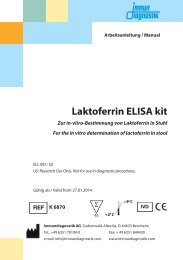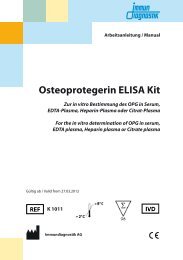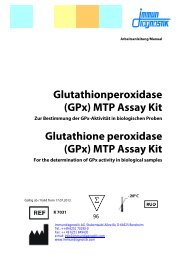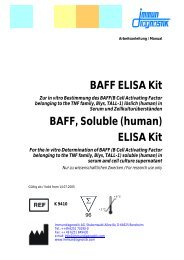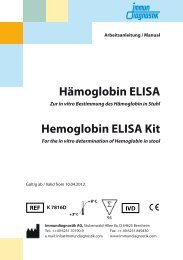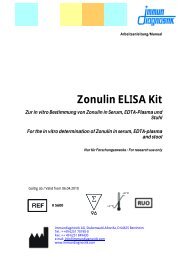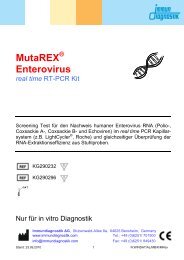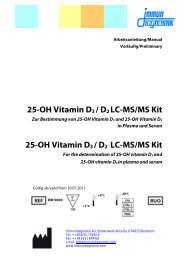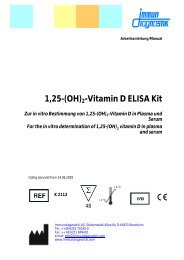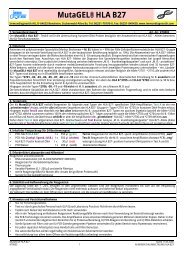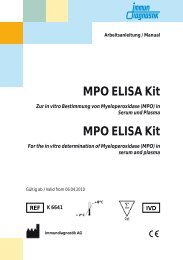Arbeitsanleitung/Manual MutaPLEX® MRSA - bei Immundiagnostik
Arbeitsanleitung/Manual MutaPLEX® MRSA - bei Immundiagnostik
Arbeitsanleitung/Manual MutaPLEX® MRSA - bei Immundiagnostik
You also want an ePaper? Increase the reach of your titles
YUMPU automatically turns print PDFs into web optimized ePapers that Google loves.
MutaPLEX ®<br />
<strong>MRSA</strong><br />
real time PCR Kit<br />
Test für den in vitro Nachweis von Methicillin-resistenten<br />
Staphyloccocus aureus (<strong>MRSA</strong>) in klinischem Probenmaterial<br />
KG190332<br />
KG190396<br />
Nur für in vitro Diagnostik<br />
Gültig ab/valid from 22.11.2011<br />
<strong>Immundiagnostik</strong> AG, Stubenwald-Allee 8a, D 64625 Bensheim<br />
Tel.: ++49 6251 70190-0<br />
Fax: ++ 49 6251 849430<br />
e.mail: Info@immundiagnostik.com<br />
www.<strong>Immundiagnostik</strong>.com
<strong>Ar<strong>bei</strong>tsanleitung</strong>/<strong>Manual</strong> <strong>MutaPLEX®</strong> <strong>MRSA</strong><br />
Komponenten<br />
Die Komponenten sind ausreichend für den Ansatz von 32 bzw. 96 Nachweisreaktionen.<br />
Bezeichnung Deckelfarbe<br />
Inhalt<br />
96 32<br />
A1 Reaction Mix Gelb 2 x 760 µl 1 x 510 µl<br />
A2 Enzyme Blau 1 x 19,2 µl 1 x 6,4 µl<br />
A3 Positive Control Rot 1 x 100 µl 1 x 50 µl<br />
A4 Negative Control Grün 1 x 100 µl 1 x 50 µl<br />
A5 Control RNA Rot 2 x 240 µl 1 x 160 µl<br />
Abkürzungen<br />
DNA Desoxyribonukleinsäure<br />
PCR Polymerase-Ketten-Reaktion<br />
Transport und Lagerung<br />
Der Transport des <strong>MutaPLEX®</strong> <strong>MRSA</strong> real time PCR Kit erfolgt gefroren auf Trockeneis. Alle<br />
Komponenten des <strong>MutaPLEX®</strong> <strong>MRSA</strong> real time PCR Kit sind direkt nach Erhalt<br />
lichtgeschützt <strong>bei</strong> -18°C zu lagern.<br />
Nach Ablauf des auf der Packung angegebenen Haltbarkeitsdatums nicht mehr<br />
verwenden! Mehrmaliges Auftauen und Einfrieren (> zweimal) der Reagenzien vermeiden,<br />
da dadurch die Sensitivität verringert werden kann. Gegebenenfalls sollten der Reaktions-<br />
Mix (A1) und die Positivkontrolle (A2) aliquotiert werden.<br />
Anwendungszweck<br />
Der <strong>MutaPLEX®</strong> <strong>MRSA</strong> real time PCR Kit dient dem Nachweis von Methillicin-resistente<br />
Staphylococcus aureus (<strong>MRSA</strong>)-DNA in klinischem Probenmaterial mittels real time PCR in<br />
offenen real time PCR-Systemen.<br />
Art und Beschaffenheit des Probenmaterials<br />
Das Ausgangsmaterial für die Nachweisreaktion ist <strong>MRSA</strong>-DNA, die aus Probenmaterial des<br />
Respirationstraktes (Nasenabstriche, tiefe Rachenabstriche) isoliert wurde.<br />
2
<strong>Ar<strong>bei</strong>tsanleitung</strong>/<strong>Manual</strong> <strong>MutaPLEX®</strong> <strong>MRSA</strong><br />
Qualitätskontrolle<br />
In Übereinstimmung mit dem ISO-zertifizierten Qualitätsmanagementsystem unseres PCR<br />
Entwicklungslabors wird jede Charge des <strong>MutaPLEX®</strong> <strong>MRSA</strong> real time PCR Kit gegen<br />
vorgegebene Spezifikationen getestet, um eine einheitliche Produktqualität zu<br />
gewährleisten.<br />
Produktgewährleistung<br />
Diese Gebrauchsinformation gilt als vollständig und richtig zum Zeitpunkt ihrer<br />
Veröffentlichung. Die <strong>Immundiagnostik</strong> AG haftet keines-falls für Neben- oder<br />
Folgeschäden, die sich im Zusammenhang mit oder in der Folge der Benutzung dieser<br />
Gebrauchsinformation ergeben. <strong>Immundiagnostik</strong> garantiert die volle Funktionsfähigkeit,<br />
wenn das Produkt entsprechend der in der Gebrauchsinformation angegebenen Anleitung<br />
erfolgt.<br />
Der Käufer muss selbst bestimmen, ob das Produkt für seine spezielle Anwendung<br />
geeignet ist. <strong>Immundiagnostik</strong> behält sich vor, Produkte jederzeit zu modifizieren, um die<br />
Funktionalität oder das Design zu verbessern.<br />
Einleitung<br />
Staphylococcus aureus sind gram-positive, traubenförmig angeordnete Bakterien, die fast<br />
überall in der Natur, auch auf der Haut und in den oberen Atemwegen von 25 bis 30 %<br />
aller Menschen vorkommen. Meist löst S. aureus keine Krankheitssymptome aus. Durch<br />
günstige Bedingungen oder ein schwaches Immunsystem kann es zu Hautinfektionen<br />
(Furunkel, Karbunkel), Muskelerkrankungen (Pyomyositis), aber auch zu<br />
lebensbedrohlichen Erkrankungen wie Lungenentzündung, Endokarditis, Toxisches<br />
Schock-Syndrom (TSS) und Sepsis kommen.<br />
Weltweit gewinnen Methicillin-resistente Staphylococcus aureus (<strong>MRSA</strong>) Stämme immer<br />
mehr an Bedeutung. Besonders in Krankenhäusern stellen sie eine große Gefahr dar, weil<br />
sie gegen alle ß-Lactam-Antibiotika (z.B. Penicillin) resistent sind und häufig noch weitere<br />
Resistenzen gegen andere Antibiotika besitzen.<br />
Der <strong>MutaPLEX®</strong> <strong>MRSA</strong> real time PCR Kit ist geeignet, um <strong>MRSA</strong> direkt in klinischen Proben<br />
zu detektieren, die sowohl Koagulase-negative Staphylokokken, als auch Methicillinresistente<br />
S. aureus enthalten.<br />
3
<strong>Ar<strong>bei</strong>tsanleitung</strong>/<strong>Manual</strong> <strong>MutaPLEX®</strong> <strong>MRSA</strong><br />
Testprinzip<br />
Der <strong>MutaPLEX®</strong> <strong>MRSA</strong> real time PCR Kit enthält spezifische Primer und<br />
Fluoreszenzfarbstoff-markierte Sonden sowie zusätzliches Material für den Nachweis von<br />
<strong>MRSA</strong>-DNA in klinischem Probenmaterial.<br />
Die Detektion der Amplifikation erfolgt in Echtzeit durch die Hybridisierung und<br />
anschließende Hydrolyse der <strong>MRSA</strong>-spezifischen Fluoreszenz-Sonden. Die Detektion<br />
erfolgt im FAM-Kanal.<br />
Zusätzlich verfügt der <strong>MutaPLEX®</strong> <strong>MRSA</strong> real time PCR Kit über eine Kontroll-DNA (A4), die<br />
während der Extraktion zugefügt und in einem hetero-logen Amplifikationssystem<br />
nachgewiesen wird. Dies ermöglicht zum einen das Aufdecken von Fehlern <strong>bei</strong> der DNA-<br />
Extraktion, zum anderen kann eine mögliche Inhibition der PCR identifiziert werden.<br />
Dadurch wird das Risiko von falsch-negativen Ergebnissen reduziert. Soll nur die PCR, nicht<br />
aber die Extraktion kontrolliert werden, so kann die Kontroll-DNA (A4) direkt dem Master-<br />
Mix zugegeben werden. Die Detektion der Kontroll-DNA (A4) erfolgt im<br />
VIC®/HEX/JOE TM /TET-Kanal.<br />
Zusätzlich benötigte Materialien und Geräte<br />
• DNA Extraktionskit<br />
• sterile Reaktionsgefäße<br />
• Pipetten (variable Volumina)<br />
• sterile Pipettenspitzen mit Filter<br />
• Tischzentrifuge<br />
• Vortexer<br />
• real time PCR Gerät (z.B. Eco, Illumina)<br />
• optische PCR Gefäße mit Verschluß<br />
• Optional: Pipettiergeräte zur Automation<br />
Wichtige Hinweise<br />
Die <strong>MutaPLEX®</strong> <strong>MRSA</strong> real time PCR muss in für diesen Zweck geeigneten Laboratorien<br />
und von speziell geschultem Personal durchgeführt werden.<br />
Die Richtlinien der Good Laboratory Practice (GLP) sind einzuhalten.<br />
Alle Proben müssen als potentiell infektiös betrachtet werden und alle mit den Proben in<br />
Berührung kommenden Gegenstände müssen als potentiell kontaminiert erachtet werden.<br />
4
<strong>Ar<strong>bei</strong>tsanleitung</strong>/<strong>Manual</strong> <strong>MutaPLEX®</strong> <strong>MRSA</strong><br />
Allgemeine Hinweise<br />
• Die Anweisungen der Gebrauchsinformation sind einzuhalten.<br />
• Areale für die Probenvorbereitung und den Ansatz des PCR-Master-Mix sollten strikt<br />
getrennt sein.<br />
• Pipetten, Röhrchen und andere Ar<strong>bei</strong>tsmaterialien dürfen nicht von einem Bereich in<br />
den anderen zirkulieren.<br />
• Immer Pipettenspitzen mit Filter verwenden.<br />
• Pipetten und Ar<strong>bei</strong>tsflächen regelmäßig mit geeigneter Dekontaminationslösung<br />
reinigen (keine ethanolhaltigen Mittel).<br />
• Komponenten verschiedener Chargen des <strong>MutaPLEX®</strong> <strong>MRSA</strong> real time PCR Kits dürfen<br />
nicht zusammen verwendet werden.<br />
Probenvorbereitung<br />
Die <strong>MutaPLEX®</strong> <strong>MRSA</strong> ist geeignet für den Nachweis von <strong>MRSA</strong>-DNA in klinischem<br />
Probenmaterial nach vorausgegangener DNA-Extraktion. Hierzu sollten kommerziell<br />
erhältliche Extraktionskits verwendet werden. <strong>Immundiagnostik</strong> empfiehlt: MutaCLEAN®<br />
DNA Blood (KG1033)<br />
Weitere Informationen zur Isolierung von DNA erhalten Sie in der Gebrauchsinformation<br />
des Extraktionskits oder vom technischen Service des Extraktionskit-Herstellers.<br />
Wichtig: Unabhängig vom verwendeten Probenmaterial sollte zusätzlich zu den Proben<br />
eine Wasserkontrolle (Reinstwasser) extrahiert werden, anhand derer sich eventuell<br />
auftretende Kontaminationen ablesen lassen. Diese Wasserkontrolle muss analog einer<br />
Probe behandelt werden.<br />
Beachten Sie bitte auch den folgenden Abschnitt „Kontroll-DNA“, Seite 6.<br />
Falls die real time PCR nicht sofort durchgeführt wird, müssen die DNA-Extrakte<br />
entsprechend der Angaben des Extraktionskit Herstellers aufbewahrt werden.<br />
5
<strong>Ar<strong>bei</strong>tsanleitung</strong>/<strong>Manual</strong> <strong>MutaPLEX®</strong> <strong>MRSA</strong><br />
Kontroll-DNA (A4)<br />
Der <strong>MutaPLEX®</strong> <strong>MRSA</strong> real time PCR Kit enthält eine Kontroll-DNA (A4), die zum einen als<br />
Kontrolle der DNA-Extraktion dient, zum anderen als Interne Kontrolle mögliche<br />
Inhibitionen der PCR aufzeigt.<br />
Verwendung als Extraktionskontrolle:<br />
Die <strong>MutaPLEX®</strong> <strong>MRSA</strong> Kontroll-DNA (A4) wird vor der eigentlichen Extraktion<br />
<strong>bei</strong>gemischt. Dazu das für eine Extraktion benötigte Puffervolumen mit der Anzahl (N) der<br />
durchzuführenden Extraktionen multiplizieren und zum Ausgleich der<br />
Pipettierungenauigkeit einen zusätzlichen Ansatz berechnen. Von der Kontroll-DNA (A4)<br />
5 µl pro Extraktion (also 5 µl x (N+1)) hinzupipettieren.<br />
Verwendung als Interne Kontrolle:<br />
Sollte keine Kontrolle der DNA-Extraktion gewünscht sein, wohl aber eine Kontrolle der<br />
PCR, so kann die Kontroll-DNA erst <strong>bei</strong>m Ansetzen der PCR zugegeben werden. In diesem<br />
Fall ist die real time PCR nach Protokoll B anzusetzen.<br />
Real time PCR<br />
Wichtige Punkte bevor Sie starten:<br />
• Beachten Sie bitte die „Wichtigen Hinweise“ auf Seite 6.<br />
• Bevor Sie die PCR ansetzen, machen Sie sich mit dem real time PCR Gerät vertraut. Die<br />
Programmierung des Temperaturprofils sollte abgeschlossen sein, bevor die real time<br />
PCR angesetzt wird.<br />
• Beachten Sie, dass in jedem PCR Lauf mindestens eine Positivkontrolle (A2) und eine<br />
Negativkontrolle (A3) enthalten sein sollten.<br />
• Alle Reagenzien müssen komplett aufgetaut, gevortext (den Reaktions-Mix NICHT<br />
vortexen, sondern durch mehrmaliges Auf-und Abpipettieren gut mischen!) und kurz<br />
abzentrifugiert werden. Halten Sie die Reagenzien stetig gekühlt auf Eis oder in einem<br />
Kühlblock (+2 bis +8°C).<br />
6
<strong>Ar<strong>bei</strong>tsanleitung</strong>/<strong>Manual</strong> <strong>MutaPLEX®</strong> <strong>MRSA</strong><br />
Durchführung<br />
Falls die Kontroll-DNA (A4) als Extraktionskontrolle verwendet werden soll, bitte Protokoll<br />
A befolgen. Soll die Kontroll-DNA (A4) nur zur Kontrolle einer möglichen Inhibition der PCR<br />
verwendet werden, bitte Protokoll B befolgen.<br />
Protokoll A<br />
Die Kontroll-DNA (A4) wurde zur DNA-Extraktion bereits zugegeben (siehe „Kontroll-<br />
DNA“, Seite 7). Der Reaktions-Mix enthält alle benötigten Komponenten außer der<br />
Probe.<br />
Die PCR wird wie folgt angesetzt:<br />
• Benötigte Anzahl optischer PCR-Reaktionsgefäße in den Kühlblock stellen.<br />
• 16 µl des Reaktions-Mix (A1) in jedes Gefäß pipettieren.<br />
• 4 µl der DNA-Eluate (inklusive der Eluate der Wasserkontrolle), der Positivkontrolle (A2)<br />
und der Negativkontrolle (A3) in die entsprechenden Gefäße hinzupipettieren.<br />
• Die Reaktionsgefäße sofort nachdem die Probe zugefügt wurde verschließen, um das<br />
Kontaminationsrisiko zu minimieren.<br />
Protokoll B<br />
Die Kontroll-DNA (A4) wird ausschließlich zur Kontrolle der PCR verwendet (siehe<br />
„Kontroll-DNA“, Seite 6). In diesem Fall wird zunächst in einem Kühlblock <strong>bei</strong> +2 bis<br />
+8 °C oder auf Eis ein Master-Mix gemäß Tabelle 1 angesetzt.<br />
Der Master-Mix enthält alle benötigten Komponenten außer der Probe. Setzen Sie für die<br />
Gesamtzahl der geplanten PCR-Ansätze mindestens einen Ansatz mehr als benötigt an.<br />
Tab. 1: Herstellung des Master-Mix (die Kontroll-DNA wird dem Master-Mix <strong>bei</strong>gemischt)<br />
Reaktionsvolumen Master-Mix Volumen<br />
16,0 µl Reaktions-Mix (A1) 16,0 µl x (N+1)<br />
0,5 µl Kontroll-DNA (A4)* 0,5 µl x (N+1)*<br />
*Die durch Zugabe der Kontroll-DNA verursachte Volumenerhöhung kann vernachlässigt<br />
werden.<br />
Die Sensitivität des Nachweissystems ist dadurch nicht beeinträchtigt.<br />
Angegebene Mengen Reaktions-Mix (A1) und Kontroll-DNA (A4) in ein steriles<br />
Reaktionsgefäß pipettieren. Den Master-Mix vorsichtig, aber gründlich mischen (nicht<br />
vortexen). Setzen Sie für die Gesamtzahl der geplanten PCR-Ansätze mindestens einen<br />
Ansatz mehr als benötigt an.<br />
7
<strong>Ar<strong>bei</strong>tsanleitung</strong>/<strong>Manual</strong> <strong>MutaPLEX®</strong> <strong>MRSA</strong><br />
Die PCR wird wie folgt angesetzt:<br />
• Benötigte Anzahl optischer PCR-Reaktionsgefäße in den Kühlblock stellen.<br />
• 16 µl des Master-Mix in jedes Gefäß pipettieren.<br />
• 4 µl der DNA-Eluate (inklusive der Eluate der Wasserkontrolle), der Positivkontrolle (A2)<br />
und der Negativkontrolle (A3) in die entsprechenden Gefäße hinzupipettieren.<br />
• Die Reaktionsgefäße sofort nachdem die Probe zugefügt wurde verschließen, um das<br />
Kontaminationsrisiko zu minimieren.<br />
PCR Temperaturprofil<br />
Für die real time PCR das in Tabelle 2 beschriebene Temperaturprofil benutzen.<br />
Tab. 2: real time PCR Temperaturprofil<br />
1. Initiale Denaturierung 10 min 95°C<br />
2. Amplifikation der DNA<br />
Anzahl der Zyklen 45<br />
Denaturierung 10 sec 95°C<br />
Annealing 40 sec 58°C<br />
Elongation 10 sec 72°C<br />
Interpretation der Ergebnisse<br />
Die <strong>MRSA</strong>-spezifische Amplifikation wird im FAM-Kanal detektiert. Die Amplifikation der<br />
Kontroll-DNA (A4) wird im VIC®/HEX/JOE TM /TET-Kanal gemessen.<br />
Folgende Ergebnisse können auftreten:<br />
• Im FAM-Kanal wird ein Signal detektiert:<br />
Das Ergebnis ist positiv, die Probe enthält <strong>MRSA</strong>-DNA.<br />
In diesem Fall ist die Detektion eines Signals im VIC®/HEX/JOE TM /TET-Kanal nicht<br />
notwendig, da eine hohe <strong>MRSA</strong>-DNA-Konzentration zu einem verminderten bzw.<br />
fehlenden Fluoreszenzsignal der Kontroll-DNA (A4) führen kann (Kompetition).<br />
• Im FAM-Kanal wird kein Signal detektiert, jedoch im VIC®/HEX/JOE TM<br />
/TET-Kanal:<br />
Das Ergebnis ist negativ, die Probe enthält keine <strong>MRSA</strong>-DNA.<br />
Das detektierte Signal der Kontroll-DNA (A4) schließt die Möglichkeit einer fehlerhaften<br />
DNA-Extraktion (falls die Kontroll-DNA (A4) als Extrak-tionskontrolle eingesetzt wurde)<br />
bzw. einer PCR-Inhibition aus.<br />
8
<strong>Ar<strong>bei</strong>tsanleitung</strong>/<strong>Manual</strong> <strong>MutaPLEX®</strong> <strong>MRSA</strong><br />
• Weder im FAM- noch im VIC®/HEX/JOE TM<br />
/TET-Kanal wird ein Signal detektiert:<br />
Es kann keine diagnostische Aussage gemacht werden.<br />
Die real time PCR wurde inhibiert, oder es trat ein Fehler während der DNA-Extraktion<br />
auf (falls die Kontroll-DNA (A4) als Extraktionskontrolle eingesetzt wurde).<br />
Abbildung 1 und Abbildung 2 zeigen Beispiele für positive und negative PCR Ergebnisse.<br />
Abb 1: Die positive Probe zeigt eine starke Amplifikation im <strong>MRSA</strong>-spezifischen FAM-<br />
Kanal, während <strong>bei</strong> der negativen Probe kein Fluoreszenzsignal detektiert wird.<br />
9
<strong>Ar<strong>bei</strong>tsanleitung</strong>/<strong>Manual</strong> <strong>MutaPLEX®</strong> <strong>MRSA</strong><br />
Abb. 2: Im VIC®/HEX/JOE TM /TET-Kanal zeigt die negative Probe ein Signal auf. In diesem<br />
Fall liegt keine Inhibition der real time PCR vor, auch verlief die Extraktion erfolgreich. Die<br />
negative Probe ist somit als tatsächlich negativ zu werten. Weder die Positiv- noch die<br />
Negativkontrolle enthalten Kontroll-DNA (außer sie wurde dem PCR Master-Mix zugefügt),<br />
daher ist kein Signal der Internen Kontrolle detektierbar.<br />
Troubleshooting<br />
Der folgende Troubleshooting Guide soll <strong>bei</strong> eventuell auftretenden Problemen mit der<br />
real time PCR behilflich sein. Sollten Sie weitere Fragen haben, wenden Sie sich bitte an<br />
unsere Wissenschaftler unter info@<strong>Immundiagnostik</strong>.com.<br />
Kein Fluoreszenzsignal im FAM-Kanal der Positivkontrolle (A3)<br />
• Der gewählte Kanal entspricht nicht dem im Protokoll angegebenen<br />
Wählen Sie den FAM-Kanal für die Analyse der <strong>MRSA</strong>-spezifischen Amplifikation und den<br />
VIC®/HEX/JOE<br />
10<br />
TM<br />
/TET-Kanal für die Amplifikation der Kontroll-DNA (A4).<br />
• Fehlerhaftes Ansetzen der real time PCR<br />
Überprüfen Sie Ihre Ar<strong>bei</strong>tsschritte und vergleichen Sie diese mit den in „Durchführung“<br />
auf den Seiten 7 bis 9 beschriebenen Ar<strong>bei</strong>tsschritten.<br />
• Fehlerhaftes real time PCR Temperaturprofil<br />
Vergleichen Sie das Temperaturprofil mit dem Protokoll (Tabelle 2, Seite 8).
<strong>Ar<strong>bei</strong>tsanleitung</strong>/<strong>Manual</strong> <strong>MutaPLEX®</strong> <strong>MRSA</strong><br />
• Falsche Lagerbedingungen des Kits, oder abgelaufenes Haltbarkeitsdatum<br />
Überprüfen Sie die Lagerbedingungen und das Haltbarkeitsdatum auf dem Kitetikett.<br />
Falls nötig, benutzen Sie einen neuen Kit und lagern Sie alle Komponenten wie auf Seite<br />
3 unter „Transport und Lagerung“ beschrieben.<br />
Schwaches oder kein Signal der Kontroll-DNA (A4) und gleichzeitiges Ausbleiben<br />
eines Signals im FAM-Kanal<br />
• Die real time PCR Bedingungen stimmen nicht mit den im Protokoll beschriebenen<br />
überein.<br />
Überprüfen Sie die real time PCR Bedingungen (Seite 9).<br />
• Real time PCR Inhibition<br />
Stellen Sie sicher, dass Sie eine der empfohlenen Extraktionsmethoden benutzen (siehe<br />
„Probenvorbereitung“, Seite 5). Beachten Sie die Herstellerangaben. <strong>Immundiagnostik</strong><br />
empfiehlt: MutaCLEAN® DNA Blood (KG1033)<br />
Stellen Sie sicher, dass ethanolhaltige Waschpuffer vollständig entfernt wurden (ein<br />
zusätzlicher Zentrifugationsschritt <strong>bei</strong> hoher Geschwindigkeit vor der DNA-Elution wird<br />
empfohlen).<br />
• Verlust der DNA während des Aufar<strong>bei</strong>tungsprozesses (falls die Kontroll-DNA (A4)<br />
als Extraktionskontrolle eingesetzt wurde)<br />
Das Ausbleiben des Signals kann auf eine fehlerhafte DNA-Extraktion hinweisen. Stellen<br />
Sie sicher, dass Sie eine geeignete Extraktionsmethode verwenden. Kommerziell<br />
erhältliche Kits werden empfohlen, und halten Sie sich an das Herstellerprotokoll.<br />
• Falsche Lagerbedingungen des Kit, oder abgelaufenes Haltbarkeitsdatum<br />
Überprüfen Sie die Lagerbedingungen und das Haltbarkeitsdatum auf dem Kitetikett.<br />
Falls nötig, benutzen Sie einen neuen Kit und lagern Sie alle Komponenten wie unter<br />
„Transport und Lagerung“ beschrieben.<br />
Detektion eines Signals im FAM-Kanal der Negativkontrolle (A3)<br />
• Kontamination des real time PCR -Ansatzes<br />
Wiederholen Sie die real time PCR in Replikaten. Falls das Ergebnis der Wiederholungen<br />
negativ sein sollte, so ereignete sich die Kontamination während der Befüllung der PCR<br />
Gefäße. Stellen Sie sicher, dass Sie die Positivkontrolle (A2) zuletzt pipettieren und<br />
verschließen Sie die Gefäße sofort nachdem Sie die jeweilige Probe zugegeben haben.<br />
Falls die Negativkontrolle (A3) in der Wiederholung wieder ein Signal im FAM-Kanal<br />
ergibt, deutet dies darauf hin, dass ein oder mehrere Kitkomponenten kontaminiert<br />
sind. Stellen Sie sicher, dass die Ar<strong>bei</strong>tsbereiche und die Geräte regelmäßig<br />
dekontaminert werden. Wiederholen Sie die real time PCR mit einem neuen Kit.<br />
11
<strong>Ar<strong>bei</strong>tsanleitung</strong>/<strong>Manual</strong> <strong>MutaPLEX®</strong> <strong>MRSA</strong><br />
MutaPLEX ®<br />
<strong>MRSA</strong><br />
real time PCR Kit<br />
Test for the in vitro detection of Methicillin-resistant<br />
Staphyloccocus aureus (<strong>MRSA</strong>) in clinical specimens.<br />
KG190332<br />
KG190396<br />
Only for in vitro Diagnostics<br />
Valid from 22.11.2011<br />
<strong>Immundiagnostik</strong> AG, Stubenwald-Allee 8a, D 64625 Bensheim<br />
Tel.: ++49 6251 70190-0<br />
Fax: ++ 49 6251 849430<br />
e.mail: Info@immundiagnostik.com<br />
www.<strong>Immundiagnostik</strong>.com<br />
12
<strong>Ar<strong>bei</strong>tsanleitung</strong>/<strong>Manual</strong> <strong>MutaPLEX®</strong> <strong>MRSA</strong><br />
Components<br />
The reagents supplied are sufficient for 96 or 32 reactions.<br />
Labelling<br />
Lid<br />
Colour<br />
Content<br />
96 32<br />
A1 Reaction Mix yellow 2 x 760 µl 1 x 510 µl<br />
A2 Enzyme blue 1 x 19,2 µl 1 x 6,4 µl<br />
A3 Positive Control red 1 x 100 µl 1 x 50 µl<br />
A4 Negative Control green 1 x 100 µl 1 x 50 µl<br />
A5 Control RNA red 2 x 240 µl 1 x 160 µl<br />
Abbreviations<br />
DNA Desoxyribonucleic Acid<br />
PCR Polymerase chain reaction<br />
Transport and Storage<br />
The <strong>MutaPLEX®</strong> <strong>MRSA</strong> real time PCR Kit is shipped on dry ice. All components must be<br />
stored at -18°C in the dark immediately after receipt. Do not use reagents after the date of<br />
expiry printed on the package. Avoid repeated thawing/freezing of the reagents, if<br />
necessary, aliquot the Reaction Mix (A1) and the Positive Control (A2).<br />
Intended Use<br />
The <strong>MutaPLEX®</strong> <strong>MRSA</strong> real time PCR Kit is a screening assay for the detection of<br />
Methillicin-resistant Staphylococcus aureus (<strong>MRSA</strong>) DNA in clinical specimens using real<br />
time PCR microplate systems (e.g. Illumina, Applied Biosystems, Stratagene, Corbett<br />
Research).<br />
Sample Material<br />
Starting material for the detection assay is <strong>MRSA</strong> DNA isolated from swabs of the<br />
respiratory tract (nasal swabs, throat swabs).<br />
Quality Control<br />
In accordance with the ISO-certified Quality Management System of our PCR developer<br />
each lot of the <strong>MutaPLEX®</strong> <strong>MRSA</strong> real time PCR Kit is tested against predetermined<br />
specifications to ensure consistent product quality.<br />
13
<strong>Ar<strong>bei</strong>tsanleitung</strong>/<strong>Manual</strong> <strong>MutaPLEX®</strong> <strong>MRSA</strong><br />
Product Warranty<br />
<strong>Immundiagnostik</strong> guarantees the performance of all products when used according to the<br />
instructions given in the instruction manual. The purchaser must determine the suitability<br />
of the product for its particular use. Should any product fail to perform satisfactorily due to<br />
any reason other than misuse, <strong>Immundiagnostik</strong> will replace it free of charge or refund the<br />
price. We reserve the right to change, alter, or modify any product to enhance its<br />
performance and design.<br />
Introduction<br />
Staphylococcus aureus are gram-positive coccal bacteria which are ubiquitously found in<br />
the environment. About 25-30 % of the human population are long-term carriers of S.<br />
aureus because the bacteria are frequently part of the skin flora found in the nose and on<br />
skin. S. aureus can cause a range of illnesses such as minor skin infections, like furuncles<br />
and abscesses, pyomyositis, but also life-threatening diseases such as pneumonia,<br />
endocarditis, toxic shock syndrome (TSS), and sepsis.<br />
Of increasing importance worldwide are Methicillin-resistant Staphylococcus aureus (<strong>MRSA</strong>)<br />
strains. Especially in hospitals <strong>MRSA</strong> present a danger, because they are resistant to all ßlactam<br />
antibiotics (e.g. penicillin) and often possess further resistances to other anitbiotics.<br />
The <strong>MutaPLEX®</strong> <strong>MRSA</strong> real time PCR Kit is suitable for the direct detection of <strong>MRSA</strong> in<br />
clinical specimens, containing both coagulase-negative staphylococci and Methicillinresistant<br />
S. aureus.<br />
Principle of the Test<br />
The <strong>MutaPLEX®</strong> <strong>MRSA</strong> real time PCR Kit contains specific primers and probes labelled with<br />
a fluorescent dye for the analysis of <strong>MRSA</strong> DNA isolated from clinical specimens.<br />
The detection of the amplification is carried out in real time via hybridization and<br />
subsequent hydrolysis of the <strong>MRSA</strong>-specific fluorescent probes. The fluorescence is<br />
measured in the FAM channel.<br />
Furthermore, <strong>MutaPLEX®</strong> <strong>MRSA</strong> real time PCR Kit contains a Control DNA (A4), which is<br />
detected in a second amplification system.<br />
Added during DNA extraction, the Control DNA (A4) allows not only the detection of PCR<br />
inhibition but also detects possible mistakes during DNA extraction. This greatly reduces<br />
the risk of false-negative results. The amplification of the Control DNA (A4) is measured in<br />
the VIC®/HEX/JOE TM<br />
/TET channel.<br />
14
<strong>Ar<strong>bei</strong>tsanleitung</strong>/<strong>Manual</strong> <strong>MutaPLEX®</strong> <strong>MRSA</strong><br />
Equipment and Reagents to be supplied by User<br />
• DNA isolation kit<br />
• Sterile microtubes<br />
• Pipets (adjustable volume)<br />
• Sterile pipet tips with filter<br />
• Table centrifuge<br />
• Vortexer<br />
• real time PCR instrument (e.g. Eco, Illumina )<br />
• optical PCR reaction tubes with lid<br />
• Optional: Liquid handling systems for automation<br />
Important Notes<br />
• The <strong>MutaPLEX®</strong> <strong>MRSA</strong> real time PCR must be performed in adequate laboratories by<br />
qualified personnel.<br />
• Good Laboratory Practice (GLP) has to be applied.<br />
• Clinical samples must always be regarded as potentially infectious material and all<br />
equipment used has to be treated as potentially contaminated.<br />
General precautions<br />
• Stick to the protocol described in the instruction manual.<br />
• Set up different laboratory areas for the preparation of samples and for the set up of the<br />
real time PCR in order to avoid contaminations.<br />
• Pipettes, tubes and other material must not circulate between those different laboratory<br />
areas.<br />
• Always use filter tips.<br />
• Regulary decontaminate equipment and benches with alcohol-free decontaminant.<br />
• Do not combine <strong>MutaPLEX®</strong> <strong>MRSA</strong> real time PCR Kit components of different lot<br />
numbers.<br />
Preparation of Samples<br />
The <strong>MutaPLEX®</strong> <strong>MRSA</strong> real time PCR TM is suitable for the detection of <strong>MRSA</strong> DNA isolated<br />
from clinical specimens with appropriate isolation methods. <strong>Immundiagnostik</strong><br />
recommends MutaCLEAN® DNA Blood (KG1033).<br />
Further information about DNA isolation are to be found in the extraction kit manual or<br />
from the extraction kit manufacturer‘s technical service.<br />
15
<strong>Ar<strong>bei</strong>tsanleitung</strong>/<strong>Manual</strong> <strong>MutaPLEX®</strong> <strong>MRSA</strong><br />
Important: In addition to the samples always run a „water control“ in your extraction, in<br />
order to detect possible contaminations during DNA extractio. Treat this water control<br />
analogous to a sample.<br />
Please pay attention to the chapter „Control DNA“.<br />
If the real time PCR is not performed immediately, store extracted DNA according to the<br />
instructions given by the DNA extraction kit‘s manufacturer.<br />
Control DNA (A4)<br />
A Control DNA (A4) is supplied to be used as extraction control. This allows the user<br />
to control the DNA extraction procedure and at the same time to check for possible<br />
PCR inhibition.<br />
Control DNA used as extraction control:<br />
<strong>MutaPLEX®</strong> <strong>MRSA</strong> Control DNA (A4) is added prior to the DNA extraction.<br />
To this end, multiply the buffer volume needed per extraction with the number of samples<br />
(including at least one water control) (N) plus 1 to compensate for inaccuracies in pipetting<br />
(N+1). Add 5 µl Control DNA (A4) per extraction (5 µl x (N+1)). Mix well. Perform the DNA<br />
extraction according to the extraction kit manufacturer‘s instructions.<br />
The Control DNA (A4) must NOT be added to the sample material directly or into the<br />
original buffer flask.<br />
Control DNA used as internal control:<br />
If control of the DNA extraction is not desired, but a control of the PCR, the Control DNA<br />
(A4) can be added to the PCR Master Mix in order to detect possible PCR inhibitions. In this<br />
case set up the real time PCR according to protocol B.<br />
Real time PCR<br />
Important Points before Starting:<br />
• Please pay attention to the „Important Notes“ on page 15.<br />
• Before setting up the PCR familiarise yourself with the real time PCR instrument and read<br />
the user manual supplied with the instrument. The programming of the thermal profile<br />
should take place before the real time PCR set up.<br />
• In every real time PCR run at least one Positive Control (A2) as well as one Negative<br />
Control (A3) should be included.<br />
16
<strong>Ar<strong>bei</strong>tsanleitung</strong>/<strong>Manual</strong> <strong>MutaPLEX®</strong> <strong>MRSA</strong><br />
• Prior to each use, all reagents should be thawed completely at room temperature, briefly<br />
vortexed (Do NOT vortex the Reaction Mix (A1) but thoroughly mix by pipetting up and<br />
down), and centrifuged very briefly. Afterwards place all reagents on ice or on a cooling<br />
block (+2 to +8°C).<br />
Procedure<br />
If the Control DNA (A4) should be used as an extraction control, please follow protocol A. If<br />
the Control DNA (A4) should be used only to control the possibility of the PCR inhibition,<br />
then please follow protocol B.<br />
Protocol A<br />
The Control DNA (A4) was added during DNA extraction (see „Control DNA“, page 5).<br />
The Reaction Mix contains all of the components needed for real time PCR except the<br />
sample.<br />
real time PCR set up<br />
• Put the number of optical PCR reaction tubes into the cooling block.<br />
• Pipet 16 µl of the Reaction Mix into each optical PCR reaction tube.<br />
• Add 4 µl of the eluates from the DNA isolation (including the eluate of the water<br />
control), the Positive Control (A2), and the Negative Control (A3) to the corresponding<br />
optical PCR reaction tube.<br />
Protocol B<br />
The Control DNA (A4) was used exclusively for the control of the real time PCR (see<br />
„Control DNA“, page 5). In this case, a Master Mix is first prepared on ice or in a<br />
cooling block (+2 to +8°C), according to Table 1.<br />
The Master Mix contains all of the components needed for real time PCR except the<br />
sample. Prepare a volume of Master Mix for at least one sample more than required, in<br />
order to compensate for pipetting inaccuracy.<br />
Table 1: Preparation of the Master Mix (Control DNA (A4) is added directly to the Master<br />
Mix)<br />
Reaction Volume Master Mix Volume<br />
16.0 µl Reaction Mix (A1) 16.0 µl x (N+1)<br />
0.5 µl Control DNA (A4)* 0.5 µl x (N+1)<br />
*The increase in volume caused by adding the Control DNA is not taken into account when<br />
preparing the PCR assay. The sensitivity of the detection system is not impaired.<br />
Pipet the indicated amounts of Reaction Mix (A1) and Control DNA (A4) into a sterile<br />
reaction tube. Mix well, but carefully (do not vortex!).<br />
17
<strong>Ar<strong>bei</strong>tsanleitung</strong>/<strong>Manual</strong> <strong>MutaPLEX®</strong> <strong>MRSA</strong><br />
real time PCR set up<br />
• Put the number of optical PCR reaction tubes into the cooling block.<br />
• Pipet 16 µl of the Master Mix into each optical PCR reaction tube.<br />
• Add 4 µl of the eluates from the DNA isolation (including the eluate of the water<br />
control), the Positive Control (A2), and the Negative Control (A3) to the corresponding<br />
optical PCR reaction tube.<br />
Real time PCR Thermal Profile<br />
For the real time PCR and the following analysis use the thermal profile shown in Table 2.<br />
Table 2: Real time PCR thermal profile<br />
1. Initial Denaturation 10 min 95°C<br />
2. Amplification of DNA<br />
Number of cycles 45<br />
Denaturation 10 sec 95°C<br />
Annealing 40 sec 58°C<br />
Extension 10 sec 72°C<br />
Data Analysis<br />
The <strong>MRSA</strong>-specific amplification is measured in the FAM channel.<br />
The amplification of the Control DNA (A4) is measured in the VIC®/HEX/JOE TM<br />
/TET channel.<br />
Following results can occur:<br />
• A signal in the FAM channel is detected:<br />
The result is positive, the sample contains <strong>MRSA</strong> DNA.<br />
In this case, detection of a signal in the VIC®/HEX/JOE TM<br />
/TET channel is inessential, as<br />
high concentrations of <strong>MRSA</strong> DNA may reduce or completely inhibit the amplification of<br />
the Control DNA (A4).<br />
• No signal in the FAM channel but a signal in the VIC®/HEX/JOE TM /TET channel is<br />
detected:<br />
The result is negative, the sample does not contain <strong>MRSA</strong> DNA.<br />
The signal of the Control DNA (A4) excludes the possibilities of DNA isolation failure (if<br />
the Control DNA (A4) was added prior to the DNA extraction) and/or PCR inhibition.<br />
• Neither in the FAM channel nor in the VIC®/HEX/JOE TM<br />
/TET channel a signal is<br />
detected:<br />
A diagnostic statement cannot be made.<br />
18
<strong>Ar<strong>bei</strong>tsanleitung</strong>/<strong>Manual</strong> <strong>MutaPLEX®</strong> <strong>MRSA</strong><br />
The DNA isolation was not successful (if Control DNA (A4) was added prior to the DNA<br />
extraction) or an inhibition of the PCR has occurred.<br />
Figure 1 and Figure 2 show examples for positive and negative real time PCR results.<br />
Fig. 1: The positive sample shows <strong>MRSA</strong>-specific amplification in the FAM channel,<br />
whereas no fluorescence signal is detected in the negative sample and the Negative<br />
Control.<br />
19
<strong>Ar<strong>bei</strong>tsanleitung</strong>/<strong>Manual</strong> <strong>MutaPLEX®</strong> <strong>MRSA</strong><br />
Fig. 2: The negative sample shows a signal in the VIC®/HEX/JOETM /TET channel. The<br />
amplification signal of the Control DNA in the negative sample shows, that the missing<br />
signal in the <strong>MRSA</strong>-specific channel (FAM) is not due to PCR inhibition or failure of DNA<br />
isolation, but that the sample is a true negative. Neither Positive nor Negative Control<br />
contain Control DNA (if Control DNA (A4) was not added to the PCR Master Mix), therefore,<br />
no signal in the VIC®/HEX/JOETM /TET channel is detected.<br />
Troubleshooting<br />
The following troubleshooting guide is included to help you with possible problems that<br />
may arise when performing a real time PCR. If you have further questions, please do not<br />
hesitate to contact our scientists on info@gerbion.com.<br />
No fluorescence signal in the FAM-channel of the Positive Control (A3)<br />
• The selected channel for analysis does not comply with the protocol<br />
Select the FAM channel for analysis of the <strong>MRSA</strong>-specific amplification and the<br />
VIC®/HEX/JOE<br />
20<br />
TM<br />
/TET channel for the amplification of the Control DNA.<br />
• Incorrect configuration of the real time PCR<br />
Check your work steps and compare with „procedure“ on page17.<br />
• The programming of the thermal profile is incorrect<br />
Compare the thermal profile with the protocol (Table 2, page 18).
<strong>Ar<strong>bei</strong>tsanleitung</strong>/<strong>Manual</strong> <strong>MutaPLEX®</strong> <strong>MRSA</strong><br />
• Incorrect storage conditions for one or more kit components or kit expired<br />
Check the storage conditions and the date of expiry printed on the kit label. If necessary,<br />
use a new kit and make sure kit components are stored as described in „Transport and<br />
Storage“.<br />
Weak or no signal of the Control DNA and simultaneous absence of a signal in the<br />
<strong>MRSA</strong>-specific FAM channel<br />
• real time PCR conditions do not comply with the protocol<br />
Check the real time PCR conditions (page 16).<br />
• real time PCR inhibited<br />
Make sure that you use an appropriate isolation method (see „Preparation of Samples“)<br />
and follow the manufacturer‘s instructions. <strong>Immundiagnostik</strong>s recommends<br />
MutaCLEAN® DNA Blood (KG1033)<br />
Make sure that the ethanol-containing washing buffer of the isolation kit has been<br />
completely removed. An additional centrifugation step at high speed is recommended<br />
before elution of the DNA.<br />
• DNA loss during isolation process<br />
The lack of an amplification signal can indicate that the DNA isolation was not<br />
successful. Make sure that you use a suitable isolation method (commercial kits are<br />
recommended) and stick to the manufacturer‘s protocol.<br />
• Incorrect storage conditions for one or more components or kit expired<br />
Check the storage conditions and the date of expiry printed on the kit label. If necessary,<br />
use a new kit and make sure kit components are stored as described in „Transport and<br />
Storage“.<br />
Detection of a fluorescence signal in the FAM-channel of the Negative Control (A3)<br />
• Contamination during preparation of the real time PCR<br />
Repeat the real time PCR in replicates. If the result is negative in the repetition, the<br />
contamination occured when the samples were pipetted into the optical PCR reaction<br />
tubes. Make sure the Positive Control (A2) is pipetted last and close the optical PCR<br />
reaction tube immediately after adding the sample.<br />
If the same result occurs, one or more of the kit components might be contaminated.<br />
Make sure that work space and instruments are decontaminated regularly. Use a new kit<br />
and repeat the real time PCR.<br />
21



